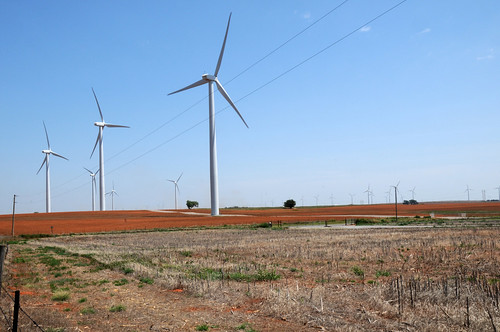
A tractor tills the soil among wind turbines in Oklahoma on August 13, 2009. USDA photo by Alice Welch.
In rural communities across the country, USDA Rural Development is bringing new energy efficiency and cost saving opportunities to Indian Country.
Choggiung Limited, a Native American Corporation in southwest Alaska, received a $20,000 energy assistance grant from USDA Rural Development to install a wind turbine at the courthouse in Dillingham – a Native-owned building and leased to the state – that has reduced its energy costs by 80 percent and is saving Choggiung about $20,000 a year. Choggiung is a for-profit Native corporation serving Tribal residents in Dillingham, Ekuk, and Portage Creek, Alaska. “This wind turbine marks a new approach to sustainable business management and renewable energy in Dillingham,” Choggiung CEO Doug Calaway said.
In the southwest, USDA awarded the Arizona, the Navajo Tribal Utility Authority a $100,000 grant to conduct energy audits that helped farmers, ranchers, and small business owners across the Navajo Nation make their operations more energy efficient and economical.
Careful stewardship and sustainable management of forest lands are essential to the culture of the Menominee Indian Tribe of Wisconsin. Since 1908, Menominee Tribal Enterprises (MTE) has operated a sawmill to provide lumber and fuel for the community. Tribal members make hand-crafted, natural wood products, such as furniture and cabinets, which are an important source of income and cultural pride for the Menominee. MTE received a $250,000 grant for a new, energy efficient boiler that produces steam used in kilns that dry the wood and to heat MTE’s building facilities. The boiler helps the environment because it is clean burning and uses less wood residue as fuel.
USDA Rural Development’s Rural Energy for America Program (REAP) is helping these and many other Tribal communities carry out their renewable energy projects. USDA supports Tribal communities, businesses, and producers in a vast array of projects. And renewable energy development is just one way we provide enormous economic opportunities in Indian Country. The REAP Program helps farmers, ranchers, and rural small business owners incorporate renewable energy and energy efficiency technology into their operations. Although government entities such as Tribes are not directly eligible for REAP assistance, individual entities and Tribally owned corporations – like those above – are eligible to apply.
Agriculture Secretary Vilsack just announced funding availability of more than $70 million in REAP grants and loan guarantees in 2014. REAP is one of many USDA programs that are expanding our energy economy. REAP also creates quality jobs in rural America and encourages U.S. energy independence. Cutting energy costs with cleaner and more efficient energy generates more income for farmers and rural businesses, and reduces greenhouse gasses that affect our climate.
With everything that Rural America provides us – abundant food, clean water, beautiful outdoor spaces, and renewable energy – the positive impact of our rural areas is further strengthened by the diversity, knowledge and traditions of our Tribal communities.
To learn more about how REAP can benefit Indian Country farmers, ranchers, and small businesses, or for help in applying, please contact the USDA Rural Development American Indian/Alaska Native Coordinator that serves your area.
No comments:
Post a Comment
Note: Only a member of this blog may post a comment.